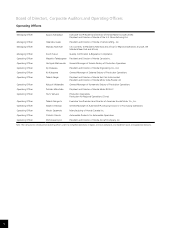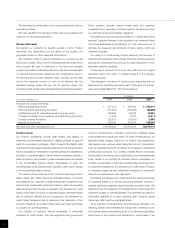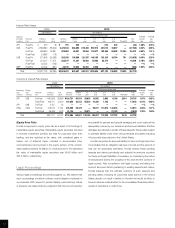Honda 2010 Annual Report Download - page 44
Download and view the complete annual report
Please find page 44 of the 2010 Honda annual report below. You can navigate through the pages in the report by either clicking on the pages listed below, or by using the keyword search tool below to find specific information within the annual report.
dismount, and gives a more comfortable ride. We have also expanded
the use of galvanized sheet iron in the new ACTY’s design to improve
the vehicle’s resistance to corrosion. Also, we introduced a new
sports-type hybrid car, the CR-Z, which combines the fun of driving
with top-class fuel economy. The CR-Z is the first hybrid car in the
world to offer a six-speed manual transmission, and it combines
Honda’s 1.5-liter i-VTEC engine with Honda’s original integrated
motor assist (IMA) hybrid system. The CR-Z offers a three-mode
driving system to suit driver preferences and meet the needs of a
broad range of driving scenes and styles. Moreover, in North America,
we newly launched the Accord Crosstour, which combines excellent
fuel economy through incorporation of variable cylinder management
and a high degree of utility in use. We also introduced the Acura ZDX,
which offers both our newly developed, six-speed automatic
transmission for a powerful ride and top-class fuel economy.
R&D expenses in this segment in fiscal 2010 were ¥369.3 billion.
R&D expenses in this segment in fiscal 2009 were ¥445.7 billion,
which reflects a correction from the amount previously disclosed. No
revisions have been made to the prior year’s consolidated financial
statements or to the notes thereto.
Power Product and Other Businesses
In the Power Product Business, we are working to develop products
that contribute to customers’ lifestyles, while strengthening our
lineup of offerings that address environmental issues.
Principal developments in this segment in Japan included the
announcement of our ENEPO EU9iGB electric generators, which
are powered by household LPG butane gas canisters. This fuel input
method makes it easier for users to purchase fuel and use these
generators as well as store the generator units for long periods
without being concerned about fuel clogging. These generators also
have large wheels, which make them easier to move, as well as
fold-up handles, making them easier to put away and store. Also in
Japan, we introduced the UMR425 backpack-style brush cutter,
which retains the ease of use on slopes and in narrow spaces of
portable brush cutters but helps to reduce accidents in farming work
by allowing the immediate release of the device’s belt at the touch of
a button. In addition, we implemented the global launch of the EU26i
handy electric power generator. This generator is based on Honda’s
original sine-wave inverter technology and supplies electricity
comparable in quality and reliability to commercially generated
power, but is also light, compact and relatively quiet (This product is
sold under the name EU3000i Handi in North America and in other
areas as the EU30i). R&D expenses in this segment in fiscal 2010
were ¥29.2 billion. R&D expenses in this segment in fiscal 2009
were ¥31.9 billion, which reflects a correction from the amount
previously disclosed. No revisions have been made to the prior
year’s consolidated financial statements or to the notes thereto.
Fundamental Research
In fundamental research, Honda is pursuing steady and broad-
ranging research activities into technologies that may lead to the
development of innovative, future products.
Principal fundamental research initiatives include the public
announcement of the U3-X test-model personal mobility unit. This
compact, one-wheel personal mobility device combines the balance
control technology developed for Honda’s ASIMO bipedal humanoid
robot with the Honda Omni Traction Drive System, which is the first
device of its kind in the world that can move not only back and forth
but also right and left as well as at any angle. Looking ahead, we will
continue R&D in this area, including the verification of the device in
practical situations. In addition, Honda has announced success in
synthesizing high-purity metal carbon nanotube compounds through
joint research conducted by Honda Research Institute USA, Inc.,
Purdue University (in Indiana) and the University of Louisville (in
Kentucky). This breakthrough is expected to open up new
possibilities for the development of high-performance, high-
efficiency, compact materials and compound materials that will find
application in energy storage, solar batteries, fuel cells, power
transmission systems, automobiles, aircraft, and other areas. We
are moving ahead with R&D to make commercial use of these
carbon nanotube compounds possible.
Expenses incurred in fundamental research are distributed among
Honda’s business segments.
600
Yen (billions)
400
200
0
6
(%)
4
2
0
R&D Expenses and R&D Expenses
as a Percentage of Net Sales
Years ended March 31
2006 2007 2008 2009 2010
R&D Expenses (left)
R&D Expenses as a Percentage of Net Sales (right)
42
























